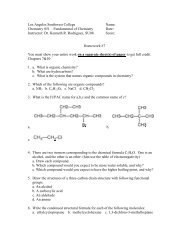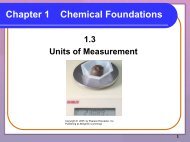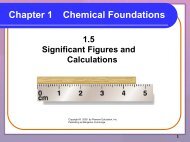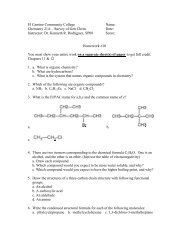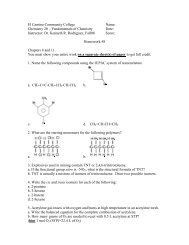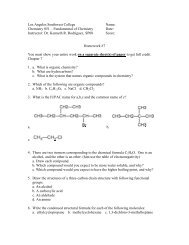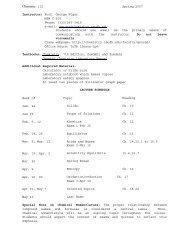3.10 Calculations Involving a Limiting Reactant
3.10 Calculations Involving a Limiting Reactant
3.10 Calculations Involving a Limiting Reactant
Create successful ePaper yourself
Turn your PDF publications into a flip-book with our unique Google optimized e-Paper software.
<strong>3.10</strong> <strong>Calculations</strong><br />
<strong>Involving</strong> a <strong>Limiting</strong><br />
<strong>Reactant</strong>
Definitions<br />
• <strong>Limiting</strong>-reactant principle – The maximum<br />
amount of product possible from a reaction is<br />
determined by the amount of reactant present<br />
in the least amount, based on its reaction<br />
coefficient and molecular weight.<br />
• <strong>Limiting</strong> reactant – the reactant present in a<br />
reaction in the least amount, based on its<br />
reaction coefficients and molecular weight. It<br />
is the reactant that determines the maximum<br />
amount of product that can be formed.<br />
Copyright © Houghton Mifflin Company. All rights reserved. 3–2
Chemical Reaction for CO 2<br />
<strong>Reactant</strong>s<br />
Product<br />
C(s)<br />
O 2 (g)<br />
CO 2 (g)<br />
Copyright © Houghton Mifflin Company. All rights reserved. 3–3
Mixture of reactants<br />
+<br />
C(s)<br />
O 2 (g)<br />
CO 2 (g) + unreacted O 2<br />
Copyright © Houghton Mifflin Company. All rights reserved. 3–4
Learning Check<br />
For the balanced equation shown below, what would be<br />
the limiting reagent if 79.6 grams of NO were reacted<br />
with 59.5 grams of O 2 ?<br />
2NO+O 2 =>2NO 2 ; NO or O 2<br />
Copyright © Houghton Mifflin Company. All rights reserved. 3–5
Solution<br />
To answer this question, calculate the grams of NO 2<br />
needed to react fully with 79.6 grams of NO and 59.5<br />
grams of O 2 , by using the balanced equation.<br />
79.6 g<br />
of NO<br />
X 1 mol of NO<br />
30.0 g of NO X 2 mol of NO 2<br />
2 mol of NO X 46 grams of NO 2<br />
1 mol of NO 2<br />
= 122.05 grams of NO 2<br />
59.5 g X 1 mol of O 2 X 2 mol of NO 2 X 46 grams of NO 2<br />
of O 2 32.0 g of O 2 1 mol of O 2 1 mol of NO 2<br />
= 171.06 grams of NO 2<br />
There is less NO 2 with NO than O 2 , therefore,<br />
the limiting reactant is NO<br />
Copyright © Houghton Mifflin Company. All rights reserved. 3–6
Learning Check<br />
For the balanced equation shown below, if 19.1 grams of<br />
CH 5 N were reacted with 88.1 grams of O 2 , how many<br />
grams of CO 2 would be produced, using the limited<br />
reactant to determine the quantity of a product that<br />
should be produced ?<br />
4CH 5 N + 11O 2 => 4CO 2 + 10H 2 O + 4NO<br />
Copyright © Houghton Mifflin Company. All rights reserved. 3–7
Solution<br />
To answer this question, calculate the grams of NO 2<br />
needed to react fully with 19.1 grams of CH 5 N and 88.1<br />
grams of O 2 , by using the balanced equation.<br />
19.1 g of<br />
CH 5 N<br />
X 1 mol of CH 5 N<br />
31.0 g of CH 5 N X 4 mol of CO 2<br />
4 mol of CH 5 O X 44 g of CO 2<br />
1 mol of NO 2<br />
= 21.1 grams of CO 2<br />
88.1 g<br />
of O 2<br />
X 1 mol of O 2<br />
32.0 g of O 2<br />
X 4 mol of CO 2<br />
11 mol of O 2<br />
X 44 grams of CO 2<br />
1 mol of CO 2<br />
= 44.1 grams of CO 2<br />
There is 21.1 g of CO 2 produced with CH 5 N<br />
than O 2 , which is the limiting reactant<br />
Copyright © Houghton Mifflin Company. All rights reserved. 3–8
Percent Yield<br />
• Percentage yield – the percentage of the<br />
theoretical amount of a product actually<br />
produced by a reaction.<br />
• Actual yield – the mass product obtained in an<br />
experiment.<br />
• Theoretical yield – the mass calculated to give<br />
the maximum amount of product.<br />
% yield = Actual yield<br />
Theoretical yield X 100<br />
Copyright © Houghton Mifflin Company. All rights reserved. 3–9
Learning Check<br />
A chemist wants to produce urea (N 2 CH 4 O) by reacting<br />
ammonia (NH 3 ) and carbon dioxide (CO 2 ). The balanced<br />
equation for the reaction is<br />
2NH 3 (g) + CO 2 (g) N 2 CH 4 O(s) + H 2 O(l)<br />
The chemist reacts 5.11 g NH 3 with excess CO 2 and<br />
isolates 3.12 g of solid N 2 CH 4 O. Calculate the<br />
percentage yield of the experiment.<br />
Copyright © Houghton Mifflin Company. All rights reserved. 3–10
To answer this question, calculate first the theoretical<br />
yield of N 2 CH 4 O that should be made. Then use the<br />
actual yield to calculate the percentage yield.<br />
5.11 g of<br />
Solution<br />
X 1 mol of NH 3<br />
NH 3<br />
X 1 mol of N 2 CH 4 O X<br />
17.0 g of NH 3 2 mol of NH 3<br />
60.1 g of N 2 CH 4 O<br />
1 mol of N 2 CH 4 O<br />
= 9.03 grams of N 2 CH 4 O is the theoretical yield<br />
The actual yield was 3.12 g of N 2 CH 4 O, so the % yield is<br />
% yield = Actual yield<br />
Theoretical yield<br />
X 100 = 3.12 g<br />
9.03 g X 100 = 34.6%<br />
Copyright © Houghton Mifflin Company. All rights reserved. 3–11
Learning Check<br />
• Methanol (CH 3 OH), also called methyl<br />
alcohol, is the simplest alcohol. It is used as<br />
a fuel in race cars and is a potential<br />
replacement for gasoline. Methanol can be<br />
manufactured by combination of gaseous<br />
carbon monoxide and hydrogen. Suppose<br />
68.5 kg CO(g) is reacted with 8.60 kg H 2 (g).<br />
Calculate the theoretical yield of methanol. If<br />
3.57x10 4 g CH 3 OH is actually produced, what<br />
is the percent yield of methanol?<br />
Copyright © Houghton Mifflin Company. All rights reserved. 3–12




